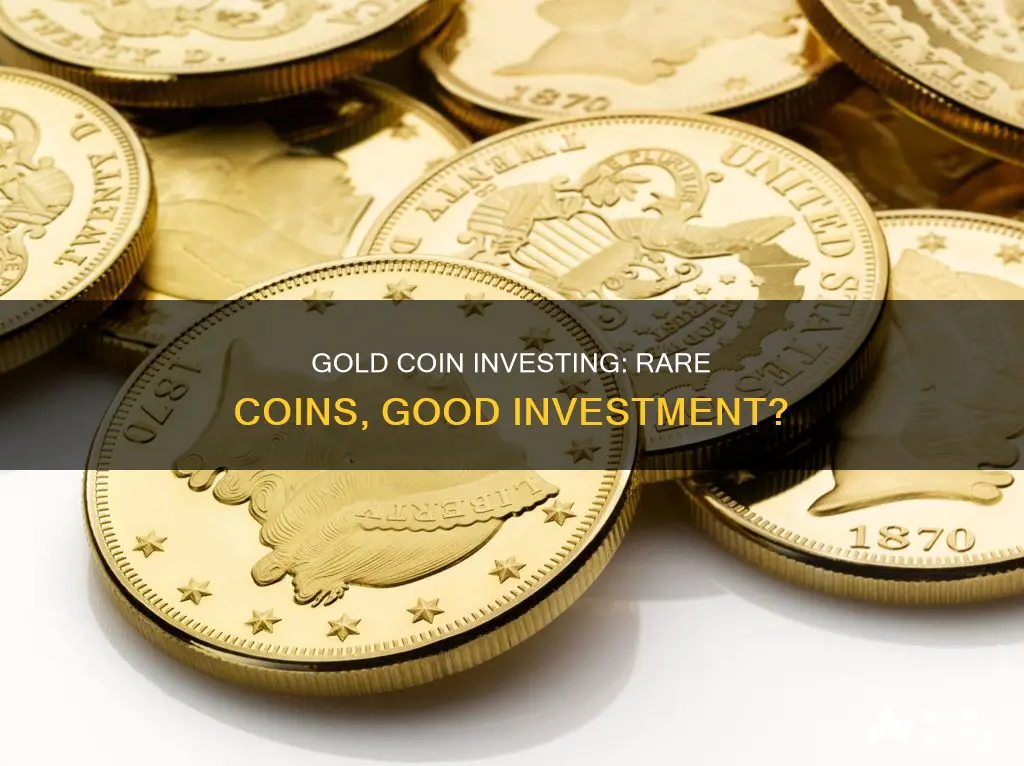
Rare gold coins are a tempting prospect for investors, but are they a good investment? Gold has long been a safe haven for investors in times of economic uncertainty, and rare coins offer the dual benefit of being a work of art with a tangible link to the past. However, investing in rare gold coins is not without its risks.
On the one hand, rare coins have proven to be a profitable investment over time, offering significant profit potential beyond the price appreciation of the gold they contain. This is because their value is determined by scarcity, age, limited production capacity, and collector demand. Rare coins are also highly liquid and easily transportable, making them a convenient and private investment.
On the other hand, the value of rare coins is highly subjective and volatile, with sudden highs and lows. The markup on numismatic coins can be much higher than standard bullion coins, and investors often overpay due to the subjective nature of a rare coin's value. The small market for rare coins also means that investors may struggle to find a buyer when it comes time to sell.
So, are rare gold coins a good investment? The answer depends on market trends and personal investment strategies. Due to their scarcity, rare coins can be a good short-term investment, but bullion may be a more stable long-term option.
What You'll Learn

Rare gold coins vs. gold bullion
When it comes to investing in precious metals, there are two main types of assets: rare coins and bullion. Both types are capable of helping you achieve your short-term and long-term investment goals. However, there are some key differences between the two that you should be aware of before making a decision.
Bullion is the term given to refined metals, such as gold, silver, platinum, or palladium, that have been minted into coins or bars. The main distinguishing factor of bullion is that its value primarily depends on its weight and the overall market value of the metal it is composed of. Bullion coins can carry a face value if minted by an official government, but often the metal value drastically exceeds the face value. For this reason, bullion is a popular option for investors and collectors alike.
On the other hand, rare coins, also known as "investment-grade coins," are valued for their scarcity, which can be due to their age, limited production capacity, or other factors. Rare coins can be certified by industry authorities to further verify their value. Due to their scarcity, rare coins have the potential to appreciate in value much faster than bullion. However, their value can also be highly volatile, making them better suited for short-term investing.
When deciding between investing in bullion or rare coins, it is essential to consider your personal investment strategy and market trends. If you are a collector interested in long-term investments, bullion may be the better option due to its relatively stable value. On the other hand, if you are looking for short-term gains and are comfortable with higher risk, rare coins could be the right choice.
It is worth noting that the markup on numismatic coins (rare coins) is typically much higher than on standard bullion coins. Premiums for rare coins can range from 25 percent to thousands of percent, depending on factors such as rarity, condition, historical significance, and demand. As a result, it is common for investors to overpay for numismatic coins, especially if they are not well-versed in the market. Therefore, it is crucial to conduct thorough research before investing in rare coins to ensure you are getting a fair deal.
Amazon Coins: A Smart Investment Move?
You may want to see also

Subjective value
The value of rare gold coins is highly subjective. While gold bullion is valued primarily based on its weight, rare coins are valued for their scarcity, which is influenced by factors such as age, limited production, and historical significance. The value of a rare coin is determined by its rarity, condition, and demand, which can vary greatly depending on the collector.
The premium for a numismatic coin is influenced by its rarity, condition, historical significance, and demand. However, the value of a rare coin is not solely based on the rise and fall of gold prices but more on its scarcity and desirability by collectors.
The value of a rare coin can be highly volatile, with sudden highs and lows, making it a risky investment option. The market for rare coins is also relatively small, resulting in a limited pool of potential buyers.
Additionally, the markup on numismatic coins is typically much higher than that of standard bullion coins, ranging from 25% to thousands of percent. This means that investors can easily overpay for a rare coin, especially if they are not knowledgeable about the market.
While rare gold coins can be a profitable investment, their value is largely subjective and dependent on various factors that can be difficult to predict. Therefore, it is crucial to conduct thorough research and consult reliable sources and experts before investing in rare gold coins.
Silver Coin Investing: Is It Worth the Risk?
You may want to see also

Market trends
Rare gold coins are a good investment in times of economic uncertainty. In today's economic climate, investors are considering converting their paper assets into precious metals and rare coins. The prices of these hard assets are currently at a fraction of their all-time highs, making it a good opportunity to diversify one's portfolio.
Gold and silver have been a safe haven for investors for centuries. Rare coins offer a convenient and popular way to diversify an investment portfolio. Financial advisors often recommend that investors allocate 10% to 20% of their portfolio to hard assets like precious metals and rare coins.
Rare coins have historically proven to be a good investment, offering significant profit potential. Prices of select coins appreciated by over 1,000% from 1976 to 1980 and 600% from 1982 to 1989. The limited supply of rare coins, coupled with increasing demand, drives up their value.
The value of rare coins is based on their scarcity, which is influenced by factors such as age and limited production capacity. The demand for these coins comes from both investors and collectors.
Bullion, on the other hand, refers to refined metals such as gold, silver, platinum, or palladium in the form of minted coins or bars. Its value primarily depends on its weight and the overall market value of the metal. Bullion coins may carry a face value if minted by an official government, but their metal value often exceeds this face value.
While bullion provides a stable investment option, rare coins can appreciate in value much faster due to their scarcity. However, the value of rare coins can be highly volatile, making them better suited for short-term investing. Bullion, with its dependence on the underlying value of the metal, is typically more stable and may be preferred by collectors for long-term investments.
The best investment strategy depends on market trends and personal preferences. Rare gold coins offer a combination of historical value, beauty, and investment potential. However, it is important to research and understand the market before making any investment decisions.
Laundromat Investment: Worth Your Money?
You may want to see also

Inflation protection
Gold has long been considered a good investment option to protect against inflation. Here are some reasons why gold bars and coins can serve as a reliable hedge against inflation:
Historical Performance
Gold has traditionally retained its value over time, even during market downturns and economic uncertainty. From 1970 to 1980, when inflation was high, gold prices skyrocketed from $35 per share to $850 per share, as per NASDAQ data. This allowed investors to shield their wealth from inflation.
Finite Supply
Gold has a limited supply, and its production cannot be rapidly increased like paper currency. During inflationary periods, the demand for gold increases as investors turn to it for protection, leading to a rise in its price.
Global Recognition
Gold is a globally accepted currency and asset, not directly linked to any single economy or market. This allows gold to weather economic and geopolitical uncertainty better than other assets. Additionally, the global market for gold means it can be easily sold to generate cash when needed.
Diversification
Gold often moves in a different direction from other assets like stocks or bonds. It is a crucial aspect of investing to spread your investments across different assets. Gold can protect your portfolio from losses when other assets falter due to inflation.
Alternative Currency
Gold is often viewed as an "alternative currency," especially in countries where the local currency is losing value. In such cases, gold or other strong currencies are used when the native currency fails.
However, it is important to note that gold is not a perfect hedge against inflation. Central banks tend to increase interest rates during inflation, and holding gold, which provides no yield, may be less advantageous than holding an interest-bearing asset when rates are higher.
Additionally, the value of rare gold coins is subjective and based on factors like rarity, condition, historical significance, and demand. The markup on these coins can be much higher than standard bullion coins, and investors may overpay if they are not knowledgeable about the market.
Therefore, while gold can be a good inflation hedge, it should be part of a broader investment strategy that considers factors like risk tolerance and investment goals.
Litecoin Investment: Should You Buy?
You may want to see also

Long-term investment
Gold coins are a good long-term investment option. Gold is a stable store of wealth and has been for millennia. The market shows that gold is an excellent way to store value for retirement or future generations. Families have long used gold as a tool to build multi-generational wealth.
Gold coins are also a good long-term investment option because they are a low-risk investment option. Since the end of the gold standard in the United States in 1971, the price of gold has remained relatively stable compared to other assets. Investors have long seen it as a safe investment because it is a physical asset with value beyond its market valuation.
Gold also has practical uses, from jewelry to spacesuit helmets. It is a scarce commodity that will always maintain a minimum demand and valuation. Gold coins are easily exchanged for cash at any time. Many gold coins are legal tender issued by governments and can be redeemed for their value at almost any bank worldwide.
Gold coins are also a good long-term investment option because they protect investors against inflation and other economic risks. Over the past 50 years, gold has moved inversely to the U.S. dollar value, as the gold market is dollar-denominated. In times of recession or inflation, gold gains value as the dollar drops.
However, it is important to note that the markup on numismatic coins is much higher than what you’ll pay for a standard bullion coin. Premiums can range from 25 percent to thousands of percent. The premium for a numismatic coin is based on rarity, condition, historical significance, and demand. The value of a rare coin is largely subjective, and different people value these aspects in different ways.
Additionally, the rare coin market is tiny, which means there will be a very small pool of potential customers when it comes time to sell. With a bullion coin, like an American Gold Buffalo, there are millions of potential customers no matter where you live or travel.
Therefore, when it comes to investing in gold coins, it is generally recommended to buy bullion coins and bars instead of numismatic coins.
Silver Coin Investment: Best Bullion Buys
You may want to see also
Frequently asked questions
The term ""rare" is relative and can be applied to many different coins. It can vary in meaning according to supply and demand or the size of a particular market.
It depends on market trends and your personal investment strategy. Rare coins can potentially appreciate in value much faster than bullion, but their value can be highly volatile, with sudden highs and lows that may make them better suited for short-term investing.
The markup on numismatic coins is much higher than what you’ll pay for a standard bullion coin. Premiums can range from 25 percent to thousands of percent. The value of a rare coin is largely subjective and based on rarity, condition, historical significance and demand.
Bullion may be more suitable for collectors interested in long-term investments. Bullion’s value depends on the underlying value of its metal, which means it is typically more stable as an investment.
Unlike some investments that only certified professionals can purchase, anyone can walk into a coin dealer and purchase gold coins. These coins are issued by governments and have a set weight in pure gold, generally between 0.1 and 1 troy ounces.







